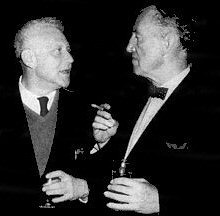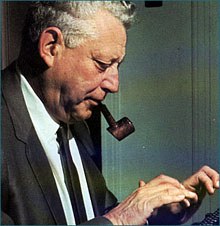Richard Maibaum
d. Jan. 4, 1991
A few years ago, Richard Maibaum told Starlog magazine, “My great kick comes from feeling that I’m a pro. That I know my job and that I have enough experience to create a solid screenplay.” He added with a smile, “I do think I can write a better Bond script than anyone else.”
Born in New York in 1909, Maibaum studied law and acted briefly before he found his real calling. His first play was produced in New York in 1932 while he was still a student at the University of Iowa. Success as a playwright led to the inevitable call from Hollywood. His first screenplay was “Gold Diggers of 1937,” followed by dozens more for Paramount, MGM and 20th Century-Fox.
After heading the Amy’s combat film division during World War II, Maibaum returned to Hollywood and Paramount. He produced “The Big Clock” and “No Man of Her Own,” and wrote “O.S.S.” (one of the first post-war spy movies), “The Great Gatsby” (his personal favorite) and “Captain Carey, U.S.A.” All three starred Alan Ladd, and his friendship with the actor led Maibaum to future Bond paterfamilias Cubby Broccoli.
Broccoli was in England in the early 50s, launching his Warwick Films company. In 1952 he signed Ladd to star in three pictures. Maibaum went along for the trip and wound up writing two of the films (“The Red Beret” and “Hell Below Zero”), beginning an association that would last the rest of his life.
In 1957, Broccoli gave him some of the Bond books to read with the idea of adapting them to the screen, but Broccoli couldn’t make a deal with a studio. By 1961, however, Broccoli and newly acquired partner Harry Saltzman had the backing they needed from United Artists, and Maibaum reportedly was given his choice of Bond stories to script. He picked the newly published Thunderball, but had to drop that idea when Kevin McClory filed suit against Ian Fleming, charging that Thunderball was based on the screenplay he and Fleming wrote for their own aborted Bond movie. Maibaum’s alternate choice was Dr. No — because, he often said, he loved the scene in which Honey Ryder walks out of the ocean wearing nothing but a fishing knife (although Ursula Andress was obliged to wear a bikini in the movie).
In the sixth issue of File Forty (FYEO’s predecessor) Linda Brevelle covered Maibaum’s appearance at the 1972 Los Angeles Film Expo. He thought then that everything in his background “seemed to coalesce” in his creation of the screen version of 007. “I had writte farce…and more serious pieces,” he explained.
“Dr. No” was quickly followed by “From Russia With Love,” Maibaum’s favorite Bond film, and the one he considered the key to the series’ success. “We had learned in the first one what it was the audience wanted,” he said. “They wanted our style. We had to crystallize it in ‘From Russia With Love’ or there wouldn’t have been a ‘Goldfinger’ or ‘Thunderball.’ I think it was the picture that made them all possible.”
Bondmania exploded with the release of “Goldfinger.” Maibaum told his Film Expo audience, “I never knew you could start serious, go to wild farce, and get away with it. The special effects department went so far in ‘Goldfinger,’ with gadgets in the car, Oddjob’s hat hits the girl running through the woods. I thought it was a bit much. The audience laughed…then when the girl was killed they were silent and serious again. We had a frame of reference they could identify with. They wanted to identify, so they could change gears. The odd thing about the Bond pictures is that you could enjoy it and it could play that latitude.”
Maibaum’s contribution to the success of the Bond series may only have been exceeded by that of Sean Connery and director Terence Young. Maibaum’s was certainly longer lived, with screenwriting credits on 13 of the 16 films. The best screenplays, “From Russia With Love” and “On Her Majesty’s Secret Service,” are the two for which Maibaum received sole credit. After the films hit bottom with “Moonraker,” Maibaum put Bond back on track in “For Your Eyes Only,” artfully combining two Fleming short stories (the first Fleming material to appear on screen since the opening scenes of “Diamonds Are Forever” a decade earlier) and restoring the physical danger and understated humor of the early films.
Richard Maibaum was 81 when he died on Jan. 4 after a short illness. Millions of filmgoers who wouldn’t recognize his name may still find something lacking in Bond adventures to come. Those of us who are well aware of his contributions know his classy touch will be sorely missed.
Originally published in For Your Eyes Only #25.





